|
City of Coppell,
Texas 1890
Photo
courtesy Clint
Skinner, October 2021 |
History in
a Pecan Shell
Settled in the
mid 1800s by James Parish, it wasn't until 1887 that a post office
was granted under the name Gibbs Station (after Lt. Gov. Barnett Gibbs).
In 1888 the St. Louis, Arkansas and Texas Railway built through the
community, giving growth a jump start. It was renamed after British
financer George A. Coppell who helped make the railroad a reality.
By 1914, Coppell had a respectable population of 450 served by most
essential businesses and wired for telephone service. Coppell suffered
from competition from neighboring cities and by 1926 it counted only
about 200 residents. This slump continued for years until the construction
(WPA) of a park on Grapevine Creek in 1936. This infrastructure lured
businesses and population. Coppell remained primarily agricultural
through the 40s and into the 50s. The 1960 census reported a population
just over 650.
By the 1970s, Coppell's population was spreading into Denton
County. In three years (1981 to 1984) it went from just under
2,000 residents to nearly 4,000. Construction of the Dallas/ Ft. Worth
Airport caused the population to explode to its current (2010) 39,000
level. In the 1990s Coppell continued developing its parks and lakes
as well as expanding its library. |
Guest
Column
What Makes
Coppell, Texas Special?
Recollections and History
by Joshua
V. Chanin |
Traveling
Down Memory Lane
Nine months ago, I received a phone call from an old principal, inviting
me to join the faculty at Coppell High School (my ole' stomping grounds).
I was extremely honored at the appointment and tremendously blessed
to receive a full-time opportunity to teach history at a superb school
as well as positivity contribute to the lives of future community
leaders. Life quickly changed… my wife and I packed our bags, departed
Commerce, and settled
in Coppell (where, ironically, I had grown up prior to my collegiate
career). Since our big move, I have continued to research various
episodes in Texas history, recently concentrating on the history of
Coppell. Despite its incorporation as a city by the state in 1955,
Coppell's story began after the Civil War. Due to its extensive and
rich past, Coppell's history ought to be further analyzed and documented
(Jean Murph and Lou Duggan did a spectacular job on compiling a brief,
yet important book on the history of Coppell in 2016 - Coppell,
Texas: A History (Charleston: The History Press, 2016)). In this
article, I intend to share a fresh angle on Coppell's vibrant story
by seamlessly blending my childhood memories with historical vignettes
on Coppell. |
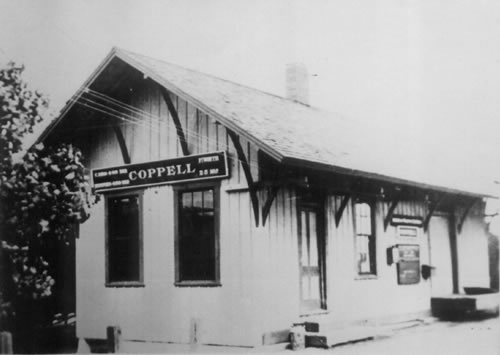 |
Coppell's train
depot on North Coppell Road, c. 1890.
Coppell was originally named "Gibbs" in honor of Barnett Gibbs, lieutenant
governor of Texas between 1885 and 1887.
Photo courtesy Coppell Historical Society Collections |
George Coppell
engraving, c. 1890.
Mr. Coppell was a prominent New York Banker who financed the St. Louis
Southwestern Railway Company, which opened its North Texas line through
Coppell on April 14, 1888.
Courtesy Joshua V. Chanin Collection |
A Family Community
My family immigrated to North
Texas in 2004 when I was ten years old. Coppell, a small suburb
north of the Dallas/Fort Worth International Airport, became my "new
American home." Our first two-story house was different from the city's
first residences. Since Coppell had been primarily an agricultural
community in the late nineteenth century, many founding families—including
the Howells, Moores, Cozbys, and Gentrys—lived in tiny, wood-framed
houses on large farms. The first brick house in Dallas
County was built by the Washington Bullock family in 1865, but
this type of home was uncommon until the 1920s. Electricity, plumbing,
and heating were gradually introduced in homes in the early twentieth
century (the luxuries were initially purchased by the affluent). During
the Great Depression and World
War II, when the state encouraged rationing and assisting the
war effort, many Coppell residents discarded their cotton
acreages in favor of chicken coops, Victory Gardens, and cow pastures.
When servicemen from the European and Pacific Theaters returned, inexpensive,
quaint houses were quickly built in the DFW metroplex. Coppell, then
home to the Dallas Power & Light Company's multi-million dollar generating
plant at North Lake, exploded in growth in the 1950s and 1960s. The
open fields that remained in Coppell in the 1970s swiftly vanished
when Dallas Developer Bill Troth oversaw a whopping $8.5 million residential
community in the eastern part of the city (over one thousand homes
on 557 acres of land were built between E. Sandy Lake and E. Belt
Line Roads). An exceptional school district, family parks, and affordable
city taxes made Coppell an attractive place to live—entrepreneur
Judy Troth Parsons recalled "the Coppell land had a lot more potential
so our whole family decided to invest in its future." At the start
of the twenty-first century, Coppell had left farming behind, embraced
the rapidly changing industrial vibe, and warmly accepted a nervous
yet excited British family to its lively community. |
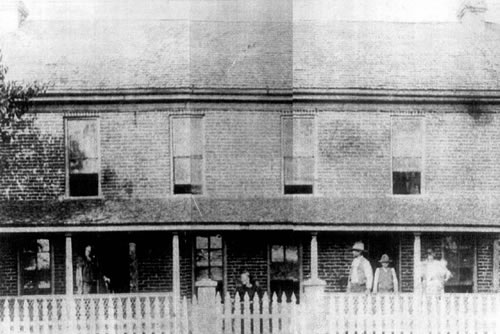 |
The Washington
Bullock's house in Coppell, c. 1870.
This was the first brick house in Dallas County, and later purchased
by businessman Joseph Walter Thweatt. Thweatt later tore down this
residence and built a frame house for his large family, which included
five sons and a daughter; today, the site is home to the Thweatt family's
windmill at Heritage Park in Old Town Coppell.
Photo courtesy Coppell Historical Society Collections |
Henry A. Ledbetter,
1943.
Ledbetter, a Coppell resident and graduate of Carrollton High School
(Coppell did not have a high school until 1965), served in the U.S.
Army during World
War II. He later married his high school sweetheart Virginia Smith
and started a family in Coppell with federal assistance from the G.I.
Bill.
Photo courtesy Coppell Historical Society Collection |
Redefining
Success in Schools
Walking to school every morning was memorable. The beautiful melodies
from chirping birds and recurring gusts of cool air in my face made
me excited to learn new material from my caring, knowledgeable teachers
when I made my trek up the road to Denton Creek Elementary and Coppell
Middle School North. I am in debt to the fantastic educators in Coppell
ISD; their dedication to pedagogy and resolute willingness to bend
over backwards to help me overcome a crippling speech impediment was
unmatched and phenomenal. Coppell ISD, which is rated one of the best
school districts in Texas, has been the academic playground for thousands
of children since 1959. Prior to that year, children in the Coppell
area attended three schools (Bethel, Gentry, and Coppell Schools)
until a brick-built facility on six-acres was constructed in South
Coppell in 1927, consolidating the academies (this later became Pinkerton
Elementary). The early structures were rudimentary, lacking toilets
and air conditioning—students used Sears Roebuck catalogues for
toilet paper!! Despite these inadequate facilities, Coppell's teachers
were among the best in the region. Ples Corbin taught at Bethel and
Coppell Schools, and, according to Clifton Harrison, introduced his
students to scholarship from his personal library and "instilled in
us high ideals and principles for living…" Another Coppell educator
who tirelessly worked to create a positive and engaging classroom
atmosphere was Sallie Kirkland Brooks. Bernice Ledbetter Graham, a
Bethel School child in the 1920s, wrote that Ms. Brooks "devoted her
nights to grading papers and planning lessons", and ensuring each
student received materials to help them succeed by traveling the many
miles to the Dallas
County superintendent's office to pick up textbooks. Today, I
am continuing the work of Corbin and Brooks as a history teacher at
Coppell High School, striving to redefine success in my classroom. |
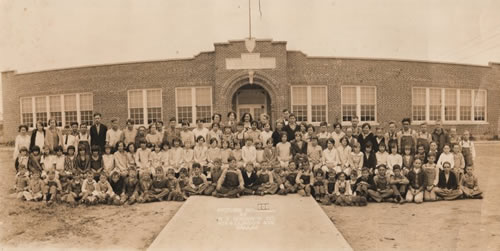 |
Students and
teachers outside Coppell School, c. 1928.
Coppell, Bethel and Gentry Schools consolidated in 1927 when a brick-built
facility was constructed in South Coppell. The school would burn down
in 1949, yet was quickly replaced. Today, this building is the home
of Pinkerton Elementary.
Photo courtesy Coppell Historical Society Collections |
Mr. Chanin at
Coppell High School, 2021.
I am a product of Coppell Schools and am blessed to have an opportunity
to teach U.S. history at Coppell High School. In my first year of
teaching (2021-2022), I wore a face shield while lecturing since the
pandemic was still raging.
Photo courtesy author Joshua V. Chanin |
A Walk in
the Park
Coppell is renowned for its safe, clean parks. A couple of weekends
ago, my wife and I strolled around Grapevine Springs Park in South
Coppell. We thoroughly enjoyed the tranquility of natural space while
chatting about our futures. Although the park appears to be an unexciting
plot of land, a historical marker details a famous encounter that
happened there in August of 1843. Sam
Houston, victor of the Texas Revolution and president of the Texas
Republic, met with the leaders of ten tribes at Grapevine Springs
Park to broker peace between the Natives and white settlers. Houston
had deep respect for the indigenous people—he had lived with
the Cherokee as a teenager, earning the nickname "Raven." Hence, "he
clothed his giant frame in a purple velvet suit embossed with embroideries
of fox heads… a well folded Indian blanket thrown in debonair manner
over his shoulder." Friendly and confident, Houston, under the park's
large oak tree, was able to create a treaty. The compromise created
a series of trading houses where Natives could bring hides and pelts
to barter for Texans' goods. Also, the treaty affirmed communication,
friendship, and aid between the two factions. The park was untouched
until the 1930s when FDR's Works Progress Administration, which offered
short-term employment to ninety men, constructed stone entry columns,
three footbridges, landscaping, and 2,500 feet (about 762 m) of gravel
sidewalks—elements that my wife and I love to admire whenever
we want to escape the commotion of the city. Today, Coppell is home
to many parks (Andy Brown, MacArthur, and Duck Pond to name a few)
which are historical and delightful. |
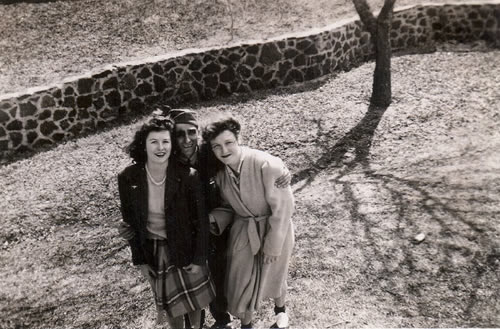 |
Two women and
a military private walk alongside a stone wall at Grapevine Springs
Park, 1942.
Once used as a location for a peace treaty between Sam Houston and
Natives, the Grapevine Springs Park received a landscaping makeover
as part of a New Deal project in the 1930s.
Photo courtesy Coppell Historical Society Collections |
A group of male
laborers at Grapevine Springs Park, 1937.
In an attempt to reduce unemployment, President Franklin D. Roosevelt
created the Works Progress Administration in 1935. The WPA employees
in Coppell enhanced the landscaping at Grapevine Springs Park.
Photo courtesy Coppell Historical Society Collections |
Grapevine Springs
Park, 2022.
My wife and I enjoy walking around this lush paradise whenever we
want to relax. The park received a Texas State Historical Marker in
October 2005.
Photo courtesy Joshua V. Chanin |
Fun in the
Sun and Fields
Since Coppell is comprised of many residential pockets and few businesses,
it was necessary for my friends and I to drive to neighboring cities
to catch a sports game or watch a movie. We often traveled to Globe
Life Park in Arlington to chow on a hot
dog and watch a Texas Rangers baseball game (as I was unfamiliar with
the game, I was usually the one who asked questions). One of the unforgettable
home games was against the Houston Astros on a sweltering day. As
the sun baked our heads, I could not help but think of the simple
activities Coppell teenagers played in the late nineteenth century.
Comparable to most teenagers in rural Coppell, Vert Parrish assisted
his blind father in managing the family farm. He recalled the grind
of his youth: "I was pretty well employed, went with my daddy everywhere,
drove the wagon." Clayta Harwell also labored in her family business
by helping her aunt at a train station. Harwell became Coppell's part-time
railroad agent at the turn of the twentieth century. Thomas Moore,
the son of Coppell farmer Charles Moore, often spent his days between
Dallas Business University and Dr. Jess Bennett's drugstore (the studious
lad was later employed at the Ford Motor Company). Repeatedly, multiple
adolescents "played in the pasture, swung on grapevines, hunted pecans
and red haws and caught crawdads," recollected Jewel "Jack" Kirkland.
The wildest rascals secretly "smoked grapevine and dipped cinnamon
for snuff" prior to smooching in one-seat buggies and catching a flick
in Grapevine, Lewisville,
or Carrollton. On Sunday afternoons,
the youth in Coppell convened at Carrollton Dam, where swim lessons
and picnics occurred. |
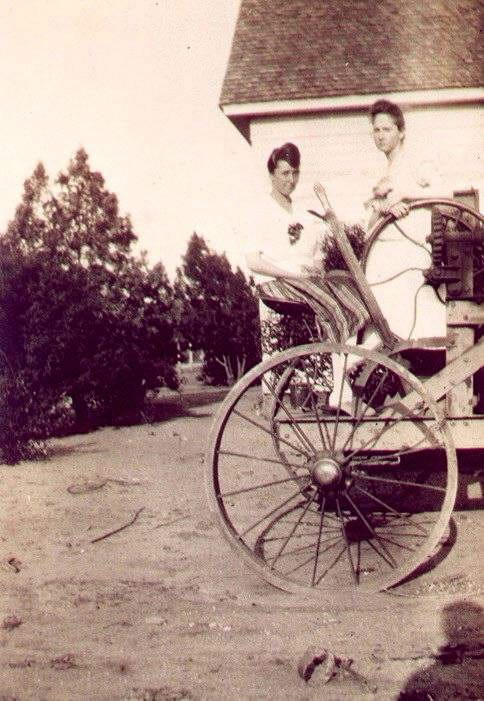 |
Jewel "Jack"
Kirkland (L) and sibling on a tractor, c. 1920.
When Coppell was a small, rural community, teenagers assisted their
parents on the farms.
Photo courtesy Coppell Historical Society Collections |
A Hearty Gathering
at Dairy Queen
After an entertaining Texas Rangers baseball game, where we chuckled
at the mascot race and merrily sang "Deep in the Heart of Texas,"
my friends and I concluded an amazing evening of comradeship at the
Dairy Queen in Coppell. While we indulged in juicy hamburgers and
multi-flavored Blizzards, the question of why this low-key, boxed
establishment was special comes to mind. Dairy Queen, the Illinois-based
restaurant franchise that is famous for its soft-serve ice cream,
opened a Coppell location at the intersection of S. Denton Tap Road
and Southwestern Boulevard in the mid-1970s. The eatery was a huge
hit, especially among the teachers at the neighboring Coppell Elementary.
Vonita White (the ISD administration building would later be named
in her honor) was a young, bright-eyed educator in the 1970s and frequently
ordered hamburgers, recalling the "very exciting" addition to a small
town. Prior to the mass availability of road maps and installation
of street signs, Dairy Queen was "a directional icon of Coppell."
Longtime resident Evelyn Elwood observed that the Dairy Queen in Coppell
"probably was our town's identity… I would usually tell people how
to get to our house from the Dairy Queen." Also, the Dairy Queen has
played host to many Coppell family celebrations-including where Bruce
MacDonald, a beloved school principal, and his wife signed their house
papers in 1981. In 2006, former restaurant owner Parrish Hence, noted
that the Dairy Queen often saw "State Farm agents meeting people and
typing up insurance." Coppell's Dairy Queen, despite a very antique
facade, has been and remains a treasured artifact and pleasant place
to create fond, long-lived memories. |
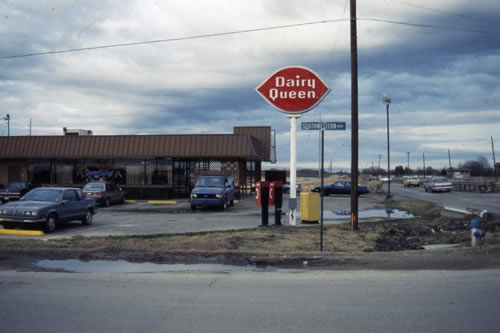 |
Coppell's Dairy
Queen, 1985.
The Dairy Queen in South Coppell has become an icon of the city since
the 1970s-residents have met friends, enjoyed ice cream, and signed
legal documents at this Dairy Queen restaurant.
Photo courtesy Coppell Historical Society Collections |
An Oasis in
the Metroplex
The City of Coppell was the backdrop of my teenage years, where I
had many opportunities to create memories that I will cherish
for a lifetime. I played with friends, walked through beautiful parks,
widened my academic horizons at schools, and feasted on treats in
Coppell. When my high school graduation beckoned, I had grown to love
this quaint community, yet was eager to explore the wider world. Ten
years later and newly married, I had different goals in mind. Eager
to start a family, I excitedly returned to Coppell, appreciating the
family-friendly vibe and excellent school district. I am grateful
to the educators who inspired me to dream big (Sandy Stubblefield,
Kolby Kerr, Angela Geiger, Laura Springer, and Diane de Waal come
to mind) … and now I am on the opposite side of the desk, giving guidance
to many scholars. As seen in this brief article, Coppell has had a
colorful history (stories that have influenced my life), and since
the "small town" magic survives to this day, Coppell will continue
to be an oasis in the metroplex for future generations, the young
and elderly. |
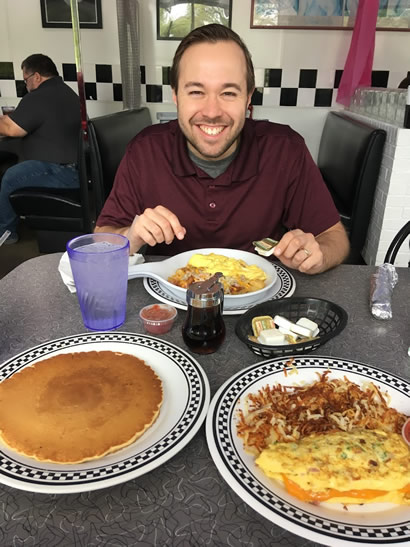 |
Enjoying a scrumptious
breakfast at the Local Diner, 2022. This popular restaurant, now located
at Old Town Coppell, has been a city staple since 1989, serving classic
American dishes and milkshakes. I used to dine at this establishment
with my teammates after weekend swim practices; I have since introduced
my wife to the legendary diner.
Photo courtesy Joshua V. Chanin |
| Texas
Escapes, in its purpose to preserve historic, endangered and vanishing
Texas, asks that anyone wishing to share their local history, stories,
landmarks and recent or vintage photos, please contact
us. |
|
|
